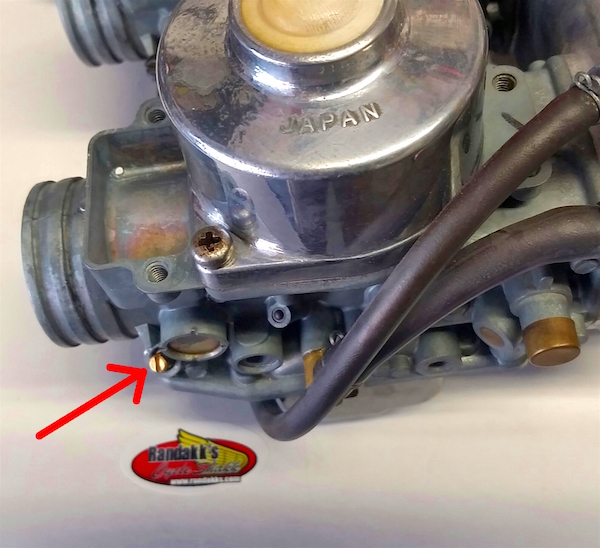“I’ve noticed that turning the idle mixture screws nets different results on each of the individual carbs on my Honda GL1000:
- #1 will kill the motor if turned all the way in
- #3 has NO EFFECT on engine speed regardless of where it is set
- #2 has what might be considered a “normal” effect
- #4 has only a very slight effect if any at all
What does this mean????? I’m a bit confused? Help please!!!!”
GL1000 Idle Mixture Fuel Screw
Keihin carbs on the vintage Honda models supported by Randakk’s Cycle Shakk have notoriously imprecise idle circuits. A certain lack of sensitivity at the idle mixture screws is characteristic of these carbs.
But, extreme hyper-sensitivity, erratic or non-responsive idle mixture screws are all characteristic symptoms that indicate one or more of these these possibilities:
- Poor sync (very common)
- Vacuum leaks
- Clogged idle circuits (this would require internal inspection/cleaning)
- Faulty ignition
- Low compression on one or more cylinders
- Choke butterflies not opening correctly
- Dirty air filter
- Internally blocked exhaust header
- Curb idle set too high (use an accurate shop tach!)
Tip: there’s not much future in trying to optimize these idle mixture screws individually. The “idle drop” method is fine, but generally I just set them to spec per the chart here. If the engine has good compression, proper ignition and the sync is close, you should get good results at the recommended idle mixture screw settings.
Modern ethanol fuel does have a slight lean-out effect, so I typically open the idle mixture screws slightly and equally from the recommended spec to add a bit of beneficial richness to the idle circuits.




I am getting ready for the new riding season. Engine starts and runs at idle (950 rpm). After 10 minutes the idle goes to 3000 rpm. Why is this happening? Also at idle headlight is very dim, turn signals do not work, horn does not work, the fan runs slow Everything worked when the bike was winterized. Battery shows 12.5 v with engine off. 14.2 v at idle (950) and 15. 3 v at 3000 rpm.
You’re chasing multiple unrelated problems:
For high erratic idle, see: http://www.randakksblog.com/lazy-slow-return-to-idle-or-erratically-high-idle/
Your electrical problems have many possibilities. You will need to evaluate the entire wiring harness, ignition switch, starter button (which deactivates the headlight for starting), headlight hi/low switch, kill switch, turn signal switch, main fuse, circuit fuses + all the zener diodes under the top-shelter. You will be looking for bad connections, excessive resistance and “voltage drops.”
Also, it’s possible to have a defective battery that tests fine, but fails under “load.”
Thanks for the great site and tips. 77 GL1000 is set at 2.5 out standard. Are you suggesting 2.75 or 3.00+ because of ethanol fuel?
I start at the recommended setting. Usually, this is fine.
I have a 1977 gl1000 and the issue is the left bank is not working , here is what I have done carbs soaked and blown out , K&L kits installed, compression good, dyna ignition. The right bank operates just fine. Any help would be welcomed.
You need to verify that fuel is actually reaching the left bank. Easy to check via the float bowl drain screws.
If not, you have an internal blockage somewhere in the plenum. Did you split the plenum during the carb cleaning? I think it’s time to dig in further. Randakk carb kits include all the bits you need for this task. K&L kits do not.
I have a 1976 Goldwing parts bike that is next on the project list(currently riding a 1975 with your carb rebuild kits installed and runs flawlessly two years later). I’ve been reading about and kicking the idea around about converting to FI’ing the engine. I have read that the earlier electrical systems would have trouble supporting the added electrical requirements. My question to you is, can’t the stator be rewound to produce more wattage? I know of a company, Baja Designs that rewinds stators to support HID lighting for running Baja and higher electrical loads.
Not recommended as there is not enough performance improvement available via that strategy. The best strategy for more charging capability is an externally mounted alternator.